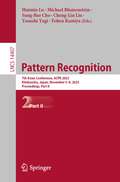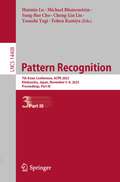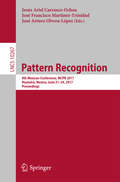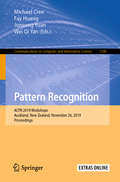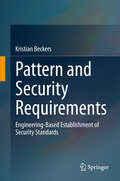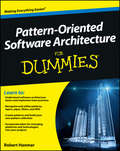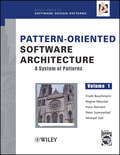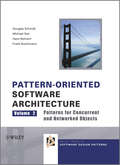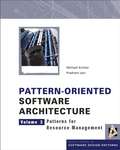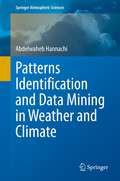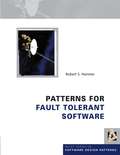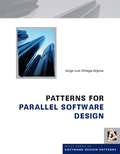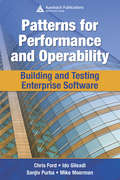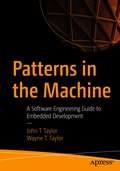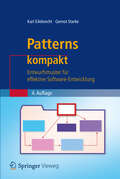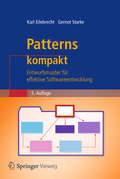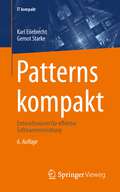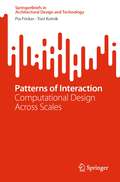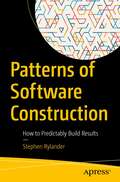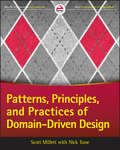- Table View
- List View
Pattern Recognition: 7th Asian Conference, ACPR 2023, Kitakyushu, Japan, November 5–8, 2023, Proceedings, Part II (Lecture Notes in Computer Science #14407)
by Huimin Lu Cheng-Lin Liu Michael Blumenstein Sung-Bae Cho Yasushi Yagi Tohru KamiyaThis three-volume set LNCS 14406-14408 constitutes the refereed proceedings of the 7th Asian Conference on Pattern Recognition, ACPR 2023, held in Kitakyushu, Japan, in November 2023. The 93 full papers presented were carefully reviewed and selected from 164 submissions. The conference focuses on four important areas of pattern recognition: pattern recognition and machine learning, computer vision and robot vision, signal processing, and media processing and interaction, covering various technical aspects.
Pattern Recognition: 7th Asian Conference, ACPR 2023, Kitakyushu, Japan, November 5–8, 2023, Proceedings, Part III (Lecture Notes in Computer Science #14408)
by Huimin Lu Cheng-Lin Liu Michael Blumenstein Sung-Bae Cho Yasushi Yagi Tohru KamiyaThis three-volume set LNCS 14406-14408 constitutes the refereed proceedings of the 7th Asian Conference on Pattern Recognition, ACPR 2023, held in Kitakyushu, Japan, in November 2023. The 93 full papers presented were carefully reviewed and selected from 164 submissions. The conference focuses on four important areas of pattern recognition: pattern recognition and machine learning, computer vision and robot vision, signal processing, and media processing and interaction, covering various technical aspects.
Pattern Recognition: 9th Mexican Conference, MCPR 2017, Huatulco, Mexico, June 21-24, 2017, Proceedings (Lecture Notes in Computer Science #10267)
by Jesús Ariel Carrasco-Ochoa, José Francisco Martínez-Trinidad and José Arturo Olvera-LópezThis book constitutes the refereed proceedings of the 9th Mexican Conference on Pattern Recognition, MCPR 2017, held in Huatulco, Mexico, in June 2017. The 29 revised full papers presented were carefully reviewed and selected from 55 submissions. The papers are organized in topical sections on pattern recognition and artificial intelligence techniques, image processing and analysis, robotics and remote sensing, natural language processing and recognition, applications of pattern recognition.
Pattern Recognition: ACPR 2019 Workshops, Auckland, New Zealand, November 26, 2019, Proceedings (Communications in Computer and Information Science #1180)
by Junsong Yuan Wei Qi Yan Fay Huang Michael CreeThis volume constitutes the refereed proceedings, presented during the ACPR 2019 Workshops, held in Auckland, New Zealand, in November 2019. The 17 full papers and 6 short papers were carefully reviewed and selected out of numerous submissions. The papers are organized according to the topics of the workshops: computer vision for modern vehicles; advances and applications on generative deep learning models; image and pattern analysis for multidisciplinary computational anatomy; multi-sensor for action and gesture recognition; towards the automatic data processing chain for airborne and spaceborne sensors.
Pattern Theory: The Stochastic Analysis of Real-World Signals
by David Mumford Agnès DesolneuxPattern theory is a distinctive approach to the analysis of all forms of real-world signals. At its core is the design of a large variety of probabilistic models whose samples reproduce the look and feel of the real signals, their patterns, and their variability. Bayesian statistical inference then allows you to apply these models in the analysis o
Pattern and Security Requirements
by Kristian BeckersSecurity threats are a significant problem for information technology companies today. This book focuses on how to mitigate these threats by using security standards and provides ways to address associated problems faced by engineers caused by ambiguities in the standards. The security standards are analysed, fundamental concepts of the security standards presented, and the relations to the elementary concepts of security requirements engineering (SRE) methods explored. Using this knowledge, engineers can build customised methods that support the establishment of security standards. Standards such as Common Criteria or ISO 27001 are explored and several extensions are provided to well-known SRE methods such as Si*, CORAS, and UML4PF to support the establishment of these security standards. Through careful analysis of the activities demanded by the standards, for example the activities to establish an Information Security Management System (ISMS) in compliance with the ISO 27001 standard, methods are proposed which incorporate existing security requirement approaches and patterns. Understanding Pattern and Security Requirements engineering methods is important for software engineers, security analysts and other professionals that are tasked with establishing a security standard, as well as researchers who aim to investigate the problems with establishing security standards. The examples and explanations in this book are designed to be understandable by all these readers.
Pattern-Oriented Software Architecture For Dummies
by Robert HanmerImplement programming best practices from the ground upImagine how much easier it would be to solve a programming problem, if you had access to the best practices from all the top experts in the field, and you could follow the best design patterns that have evolved through the years. Well, now you can. This unique book offers development solutions ranging from high-level architectural patterns, to design patterns that apply to specific problems encountered after the overall structure has been designed, to idioms in specific programming languages--all in one, accessible, guide. Not only will you improve your understanding of software design, you'll also improve the programs you create and successfully take your development ideas to the next level.Pulls together the best design patterns and best practices for software design into one accessible guide to help you improve your programming projects Helps you avoid re-creating the wheel and also meet the ever-increasing pace of rev cycles, as well as the ever-increasing number of new platforms and technologies for mobile, web, and enterprise computing Fills a gap in the entry-level POSA market, as well as a need for guidance in implementing best practices from the ground upSave time and avoid headaches with your software development projects with Pattern-Oriented Software Architecture For Dummies.
Pattern-Oriented Software Architecture, A System of Patterns: A System Of Patterns (Wiley Software Patterns Series #1)
by Hans Rohnert Michael Stal Frank Buschmann Regine Meunier Peter SommerladPattern-oriented software architecture is a new approach to software development. This book represents the progression and evolution of the pattern approach into a system of patterns capable of describing and documenting large-scale applications. A pattern system provides, on one level, a pool of proven solutions to many recurring design problems. On another it shows how to combine individual patterns into heterogeneous structures and as such it can be used to facilitate a constructive development of software systems. Uniquely, the patterns that are presented in this book span several levels of abstraction, from high-level architectural patterns and medium-level design patterns to low-level idioms. The intention of, and motivation for, this book is to support both novices and experts in software development. Novices will gain from the experience inherent in pattern descriptions and experts will hopefully make use of, add to, extend and modify patterns to tailor them to their own needs. None of the pattern descriptions are cast in stone and, just as they are borne from experience, it is expected that further use will feed in and refine individual patterns and produce an evolving system of patterns. Visit our Web Page http://www.wiley.com/compbooks/
Pattern-Oriented Software Architecture, Patterns for Concurrent and Networked Objects: A System Of Patterns (Wiley Software Patterns Series #1)
by Hans Rohnert Douglas C. Schmidt Michael Stal Frank BuschmannDesigning application and middleware software to run in concurrent and networked environments is a significant challenge to software developers. The patterns catalogued in this second volume of Pattern-Oriented Software Architectures (POSA) form the basis of a pattern language that addresses issues associated with concurrency and networking. The book presents 17 interrelated patterns ranging from idioms through architectural designs. They cover core elements of building concurrent and network systems: service access and configuration, event handling, synchronization, and concurrency. All patterns present extensive examples and known uses in multiple programming languages, including C++, C, and Java. The book can be used to tackle specific software development problems or read from cover to cover to provide a fundamental understanding of the best practices for constructing concurrent and networked applications and middleware. About the AuthorsThis book has been written by the award winning team responsible for the first POSA volume "A System of Patterns", joined in this volume by Douglas C. Schmidt from University of California, Irvine (UCI), USA.Visit our Web Page
Pattern-Oriented Software Architecture, Patterns for Resource Management
by Prashant Jain Michael KircherThe first volume of the POSA pattern series introduced a broad-spectrum of general-purpose patterns in software design and architecture. The second narrowed the focus to fundamental patterns for building sophisticated concurrent and networked software systems and applications. This volume uses design patterns to present techniques for implementing effective resource management in a system.The patterns are covered in detail making use of several examples providing directions to the readers on how to implement the presented patterns. Additionally, the volume presents a thorough introduction into resource management and a case study where the patterns are applied to the domain of mobile radio networks. The patterns are grouped by different areas of resource management and hence address the complete lifecycle of resources: resource acquisition, coordination and release.
Patterns Identification and Data Mining in Weather and Climate (Springer Atmospheric Sciences)
by Abdelwaheb HannachiAdvances in computer power and observing systems has led to the generation and accumulation of large scale weather & climate data begging for exploration and analysis. Pattern Identification and Data Mining in Weather and Climate presents, from different perspectives, most available, novel and conventional, approaches used to analyze multivariate time series in climate science to identify patterns of variability, teleconnections, and reduce dimensionality. The book discusses different methods to identify patterns of spatiotemporal fields. The book also presents machine learning with a particular focus on the main methods used in climate science. Applications to atmospheric and oceanographic data are also presented and discussed in most chapters. To help guide students and beginners in the field of weather & climate data analysis, basic Matlab skeleton codes are given is some chapters, complemented with a list of software links toward the end of the text. A number of technical appendices are also provided, making the text particularly suitable for didactic purposes.The topic of EOFs and associated pattern identification in space-time data sets has gone through an extraordinary fast development, both in terms of new insights and the breadth of applications. We welcome this text by Abdel Hannachi who not only has a deep insight in the field but has himself made several contributions to new developments in the last 15 years. - Huug van den Dool, Climate Prediction Center, NCEP, College Park, MD, U.S.A.Now that weather and climate science is producing ever larger and richer data sets, the topic of pattern extraction and interpretation has become an essential part. This book provides an up to date overview of the latest techniques and developments in this area. - Maarten Ambaum, Department of Meteorology, University of Reading, U.K.This nicely and expertly written book covers a lot of ground, ranging from classical linear pattern identification techniques to more modern machine learning, illustrated with examples from weather & climate science. It will be very valuable both as a tutorial for graduate and postgraduate students and as a reference text for researchers and practitioners in the field. - Frank Kwasniok, College of Engineering, University of Exeter, U.K.
Patterns for Computer-Mediated Interaction
by Stephan Lukosch Till SchummerWritten by well-respected experts, this how-to guide provides patterns for the design of human computer human interaction (HCHI). An increasing number of applications are currently designed for use by more than one user, eg: multi-player games, interactive web sites, mobile phones, collaborative learning systems, interactive workspaces and smart environments. In these areas there is a shift from (HCI) human computer interaction to (HCHI) human computer human interaction. The role of patterns in this movement is twofold: 1st - patterns focus on the human user of the system; 2nd - patterns assist developers in the development process of groupware applications.
Patterns for Fault Tolerant Software
by Robert HanmerSoftware patterns have revolutionized the way developer's and architects think about how software is designed, built and documented.This new title in Wiley's prestigious Series in Software Design Patterns presents proven techniques to achieve patterns for fault tolerant software. This is a key reference for experts seeking to select a technique appropriate for a given system.Readers are guided from concepts and terminology, through common principles and methods, to advanced techniques and practices in the development of software systems. References will provide access points to the key literature, including descriptions of exemplar applications of each technique.Organized into a collection of software techniques, specific techniques can be easily found with sufficient detail to allow appropriate choices for the system being designed.
Patterns for Parallel Software Design
by Jorge Luis Ortega-ArjonaEssential reading to understand patterns for parallel programmingSoftware patterns have revolutionized the way we think about how software is designed, built, and documented, and the design of parallel software requires you to consider other particular design aspects and special skills. From clusters to supercomputers, success heavily depends on the design skills of software developers.Patterns for Parallel Software Design presents a pattern-oriented software architecture approach to parallel software design. This approach is not a design method in the classic sense, but a new way of managing and exploiting existing design knowledge for designing parallel programs. Moreover, such approaches enhance not only build-time properties of parallel systems, but also, and particularly, their run-time properties.Features known solutions in concurrent and distributed programming, applied to the development of parallel programsProvides architectural patterns that describe how to divide an algorithm and/or data to find a suitable partition and link it with a programming structure that allows for such a divisionPresents an architectural point of view and explains the development of parallel softwarePatterns for Parallel Software Design will give you the skills you need to develop parallel software.
Patterns for Performance and Operability: Building and Testing Enterprise Software
by Chris Ford Ido Gileadi Sanjiv Purba Mike MoermanApplications that work perfectly in controlled settings often fail in production environments, impacting business operations. This book explores a frequently overlooked aspect of software development: non-functional design and testing. In the real world, hostile production conditions and changing business usage can lead to unforeseen downtime or unacceptable system performance. Written by technologists and based on real field experience, the book examines common failure scenarios, defensive design patterns, and effective performance strategies.
Patterns in Past Settlements: Geospatial Analysis of Imprints of Cultural Heritage on Landscapes (Springer Remote Sensing/Photogrammetry)
by M.B. RajaniThis book is an introduction to a new branch of archaeology that scrutinises landscapes to find evidence of past human activity. Such evidence can be hard to detect at ground-level, but may be visible in remote sensing (RS) imagery from aerial platforms and satellites. Drawing on examples from around the world as well as from her own research work on archaeological sites in India (including Nalanda, Agra, Srirangapatna, Talakadu, and Mahabalipuram), the author presents a systematic process for integrating this information with historical spatial records such as old maps, paintings, and field surveys using Geographic Information Systems (GIS) to gain new insights into our past. Further, the book highlights several instances where these insights are actionable -- they have been used to identify, understand, conserve, and protect the fragile remnants of our past. This book will be of particular interest not only to researchers in archaeology, history, art history, and allied fields, but to governmental and non-governmental professionals working in cultural heritage protection and conservation.
Patterns in the Machine: A Software Engineering Guide to Embedded Development
by John T. Taylor Wayne T. TaylorDiscover how to apply software engineering patterns to develop more robust firmware faster than traditional embedded development approaches. In the authors’ experience, traditional embedded software projects tend towards monolithic applications that are optimized for their target hardware platforms. This leads to software that is fragile in terms of extensibility and difficult to test without fully integrated software and hardware. Patterns in the Machine focuses on creating loosely coupled implementations that embrace both change and testability. This book illustrates how implementing continuous integration, automated unit testing, platform-independent code, and other best practices that are not typically implemented in the embedded systems world is not just feasible but also practical for today’s embedded projects. After reading this book, you will have a better idea of how to structure your embedded software projects. You will recognize that while writing unit tests, creating simulators, and implementing continuous integration requires time and effort up front, you will be amply rewarded at the end of the project in terms of quality, adaptability, and maintainability of your code. What You Will Learn Incorporate automated unit testing into an embedded projectDesign and build functional simulators for an embedded projectWrite production-quality software when hardware is not availableUse the Data Model architectural pattern to create a highly decoupled design and implementationUnderstand the importance of defining the software architecture before implementation starts and how to do itDiscover why documentation is essential for an embedded projectUse finite state machines in embedded projects Who This Book Is For Mid-level or higher embedded systems (firmware) developers, technical leads, software architects, and development managers.
Patterns kompakt
by Gernot Starke Karl EilebrechtPatterns kompakt fasst die wichtigsten Entwurfsmuster zusammen, die Sie für Software-Entwicklung benötigen. Software-Entwickler, -Architekten und -Designer finden darin effektiv anwendbare Lösungen für tägliche Entwurfsprobleme. Die vierte Auflage wurde um aktuelle Patterns erweitert und komplett überarbeitet. Das Buch gliedert Patterns anhand typischer Aspekte des Software-Entwurfs: Basismuster für mehr Flexibilität und Wartbarkeit, Präsentation, Kommunikation und Verteilung, Integration und Persistenz. Patterns kompakt richtet sich an Praktiker: Software-Entwickler, -Designer, -Architekten und alle, die einen praxisorientierten Überblick zu Entwurfsmustern benötigen.
Patterns kompakt: Entwurfsmuster für effektive Softwareentwicklung (IT kompakt)
by Gernot Starke Karl EilebrechtPatterns kompakt fasst die wichtigsten Entwurfsmuster zusammen, die Sie für Softwareentwicklung benötigen. Softwareentwickler und -architekten finden darin effektiv anwendbare Lösungen für tägliche Entwurfsprobleme. Das Buch gliedert Patterns anhand typischer Aspekte des Softwareentwurfs: - Basismuster für mehr Flexibilität und Wartbarkeit- Präsentation- Kommunikation und Verteilung- Integration- PersistenzDie nunmehr fünfte (aktualisierte und erweiterte) Auflage enthält darüber hinaus ein Kapitel zum Thema Software-Inbetriebnahme.Patterns kompakt richtet sich an Praktiker: Softwareentwickler, -architekten sowie alle, die einen praxisorientierten Überblick zu Entwurfsmustern benötigen.
Patterns kompakt: Entwurfsmuster für effektive Softwareentwicklung (IT kompakt)
by Gernot Starke Karl EilebrechtPatterns kompakt fasst die wichtigsten Entwurfsmuster zusammen, die Sie für Softwareentwicklung benötigen. Sie finden praxisnahe und effektiv anwendbare Lösungen für typische Entwurfsprobleme.Das Buch gliedert Patterns anhand typischer Aspekte des Softwareentwurfs: Basismuster für mehr Flexibilität und WartbarkeitPräsentationKommunikation und VerteilungIntegrationPersistenzDie sechste aktualisierte und erweiterte Auflage erklärt darüber hinaus weitere Musterkategorien.Patterns kompakt unterstützt mit praktischen Tipps zur Softwareentwicklung und -architektur und gibt einen praxisorientierten Überblick zu wesentlichen Entwurfsmustern.
Patterns of Data Modeling
by Michael BlahaBest-selling author and database expert with more than 25 years of experience modeling application and enterprise data, Dr. Michael Blaha provides tried and tested data model patterns, to help readers avoid common modeling mistakes and unnecessary frustration on their way to building effective data models. Unlike the typical methodology book, Patterns of Data Modeling provides advanced techniques for those who have mastered the basics. Recognizing that database representation sets the path for software, determines its flexibility, affects its quality, and influences whether it succeeds or fails, the text focuses on databases rather than programming. It is one of the first books to apply the popular patterns perspective to database systems and data models. It offers practical advice on the core aspects of applications and provides authoritative coverage of mathematical templates, antipatterns, archetypes, identity, canonical models, and relational database design.
Patterns of HCI Design and HCI Design of Patterns
by Ahmed SeffahAs interactive systems are quickly becoming integral to our everyday lives, this book investigates how we can make these systems, from desktop and mobile apps to more wearable and immersive applications, more usable and maintainable by using HCI design patterns. It also examines how we can facilitate the reuse of design practices in the development lifecycle of multi-devices, multi-platforms and multi-contexts user interfaces. Effective design tools are provided for combining HCI design patterns and User Interface (UI) driven engineering to enhance design whilst differentiating between UI and the underlying system features. Several examples are used to demonstrate how HCI design patterns can support this decoupling by providing an architectural framework for pattern-oriented and model-driven engineering of multi-platforms and multi-devices user interfaces. Patterns of HCI Design and HCI Design of Patterns is for students, academics and Industry specialists who are concerned with user interfaces and usability within the software development community.
Patterns of Interaction: Computational Design Across Scales (SpringerBriefs in Architectural Design and Technology)
by Pia Fricker Toni KotnikThis book is a reflection on contemporary computational design thinking at the intersection of architecture, urban design, and landscape architecture, in a time marked by complex challenges like climate change, urbanization and population growth. Based on a critical rethinking of the notion of ground and the relation between the manmade and the natural environment, an understanding of architecture as regenerative practice is proposed. It aims at a built environment as landscape, at an architecture of prosthetic nature. The design approach is illustrated by a number of design experiments conducted within a studio setting and complemented by a series of conversations with leading experts on sustainable design and landscape architecture.
Patterns of Software Construction: How to Predictably Build Results
by Stephen RylanderMaster how to implement a repeatable software construction system. This book closely examines how a system is designed to tie a series of activities together that are needed when building software-intensive systems. Software construction and operations don't get enough attention as a repeatable system. The world is stuck in agile backlog grooming sessions, and quality is not increasing. Companies' budgets are shrinking, and teams need a way to get more done with less, consistently. This topic is very relevant to our current economic conditions and continuing globalization trends. A reason we constantly need more hands-on-the-keyboards is because of all the waste created in development cycles. We need more literature on how to "do software" not just write software. These goals are accomplished using the concept of evolutions, much like the Navy SEALS train their team members. For LIFT, the evolutions are: Plan, Build, Test, Release, Operate and Manage. The entire purpose of the book is instructing professionals how to use these distinct evolutions while remaining agile. And then, inside of each evolution, to explicitly break down the inputs to the evolution, outputs and series of activities taking place. Patterns of Software Construction clearly outlines how together this becomes the system.What You Will LearnOptimize each evolution of a software delivery cycleReview best practices of planning, highest return in the build cycle, and ignored practices in test, release, and operate Apply the highest return techniques during the software build evolutionWho This Book is ForManagers, developers, tech lead, team lead, aspiring engineer, department leaders in corporations, executives, small business owner, IT Director
Patterns, Principles, and Practices of Domain-Driven Design
by Scott Millett Nick Tuneof concept in action that other books have only covered theoreticallyCovers the patterns of CQRS, Messaging, REST, Event Sourcing and Event-Driven ArchitecturesAlso ideal for Java developers who want to better understand the implementation of DDD
